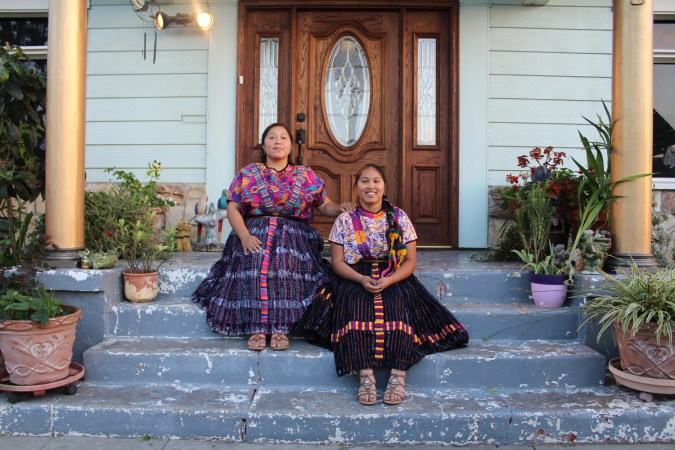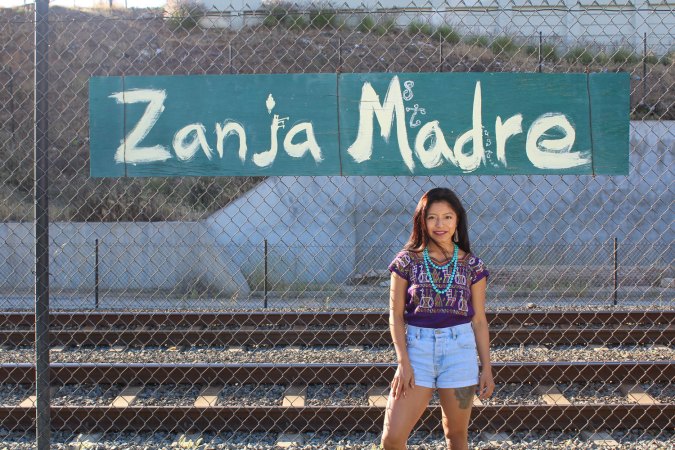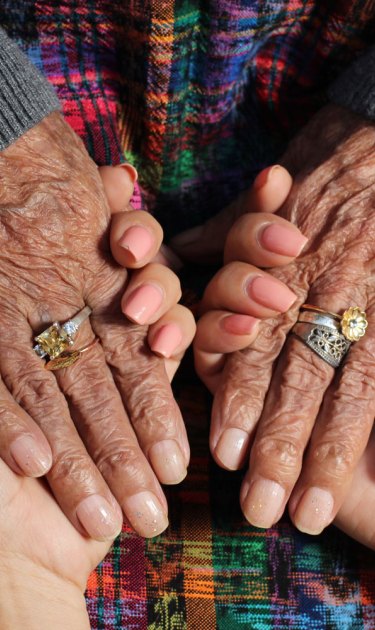In the 1990s, thousands of Mayas like Vivian Macario fled a post-war Guatemala, where in the previous two decades state policies of genocide, forced displacement, and scorched earth attacks ravaged Indigenous communities during the Central American country’s civil war. Hoping to start a new life, Macario left her hometown of Quetzaltenango and migrated north with her mother before settling down in Los Angeles, a common destination for Maya immigrants.
Despite the pressures of assimilation into dominant US culture, Macario maintains her Maya culture alive, as seen in a photograph of her and her 12-year-old daughter, Jackelyn. In this portrait, currently on view in Maya Womxn in L.A. at Las Fotos Project, Macario and Jackelyn sit on the footsteps of their home, dressed in a woven huipil blouse and corte skirt, traditional K’iche’ Maya garments that Macario’s grandmother inspired her to wear.

Maya Womxn in L.A., a multimedia exhibit of photographs, oral histories, and an interactive diaspora mapping activity, features more than 40 Maya-American women, who carry on the traditions and values of Indigenous Guatemalans in Los Angeles. The exhibit is unique in its inclusion of only Maya or Guatemalan women as photographers and mentors in the documentation process; for 12 weeks, six Maya- or Guatemalan-identified teenage girls researched, photographed, and interviewed their subjects with the guidance of teaching assistants at Las Fotos Project, a photography program for young Latinas.
For teaching artist Floridalma Boj Lopez, the success of the exhibit relied on providing Maya girls and women the opportunity to portray themselves as they want to be seen. Boj Lopez first envisioned the project in reaction to a racist magazine cover she saw in 2017. For its July issue, Look Magazine photographed a white, Guatemalan-American fashion designer standing in front of a small crowd of Maya women. Boj Lopez immediately recognized the white supremacist undertones of the photograph that are common in Western portrayals of Indigenous women.
“For me, it was something that I had seen multiple times before: In this mainstream perspective, Mayan women are still just a backdrop, the ones that can produce the pretty textiles, but who don’t have to speak or be accredited as the intellectual designers,” Boj Lopez says. “I wanted to create an opportunity for Mayan women to be in charge of the pictures that are created about them.”

The series of more than 30 images encompasses a wide range of Maya experiences; the women featured include 4-year-old children to 96-year-old great-grandmothers, first-generation and second-generation immigrants, Guatemalan-Mexicans, university students, social workers, and actresses. Yet, despite their differences, many Maya women encounter much of the same pressures to adapt to Latino spaces by giving up their language, traditional dress, and customs, says Boj Lopez. Maya immigrants, in particular, may fear wearing their traditional clothes, which can mark these women as recent arrivals to the United States and therefore, targets for immigration enforcement officers.
In the portraits, each woman decides on how to represent their Indigenous heritage, selecting their wardrobe, pose, and setting. Some women wear the entire traditional dress – a huipil, corte, and sandals – while others mix it up, donning a huipil with jeans and large hoops. Some prefer not to wear the traditional clothes at all. In other photographs, the location of the photo shoot, such as the family home – teeming with plants and nature – reveals an important aspect of their Maya spirituality. In another photograph, a pose, such as one of three generations of women embracing each other may stand out in the frame and show a prevalence of family and community common in Maya life.
Still, the huipil and the corte are a common thread in the photographs. And for many subjects, the significance behind wearing the traditional garments goes beyond representation and identity and offers a powerful, political statement on Indigenous resistance.
“My ancestors, my grandparents, my parents have lived through colonization, wars, and genocide, yet here I stand wearing the one corte that I own, the one corte that my grandmother and I share; that is resilience,” wrote 26-year-old Maricela Lopez in a caption to a photograph of herself holding a vintage photograph of her grandparents as she stood wearing a corte. “By wearing my corte in Los Angeles, I am telling white supremacy, ‘Look at me. You tried to erase my existence, but here I am. My resilient ancestors prevailed.’”
Maya Womxn in L.A. is on view until June 9, 2018. Learn more here.
Update, May 25 at 8:17 p.m. ET: An earlier version of this piece misspelled Vivian Macario’s last name and Floridalma Boj Lopez’s title. It has been corrected.




